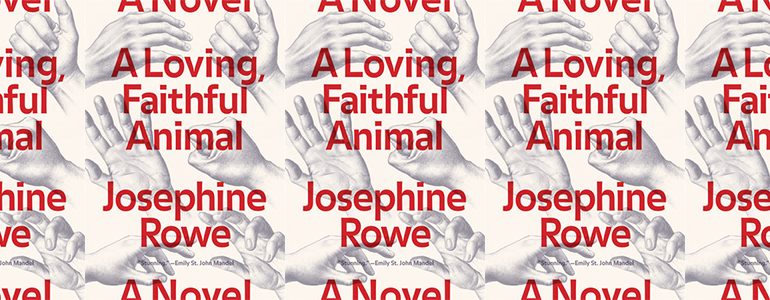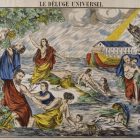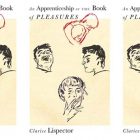A Loving, Faithful Animal’s Story of a Scar

We don’t think of scars as having patterns. They can be big or small, noticeable or so faint you barely remember that they’re there. They can be the physical markers of a serious injury or the shadow of a forgotten one. They don’t give up their meaning easily. It’s what makes the scar an intriguing, and also tough, structure to map a novel onto.
The most familiar narrative structure is the dramatic arc, with its rising action, climax, and falling action. It’s outlined in most books on fiction writing, and it’s influenced many classic Western stories. There’s nothing wrong with the dramatic arc, but its ubiquity can mean readers struggle to find meaning in texts—and, if you’re as obsessed with storytelling and fate as I am, even life events—that don’t fit that pattern. Recently, I found myself thinking about this disconnect while reading Josephine Rowe’s A Loving, Faithful Animal (2016), a novel I was deeply moved by even as I struggled to organize my impressions into a clear framework of the book’s intent.
Rereading Jane Alison’s Meander, Spiral, Explode: Design and Pattern in Narrative (2019) was a great starting point. Alison is passionately interested in finding new structures to explain and interpret fiction since “[s]o many other patterns…trac[e] other deep motions in life.” She draws from nature to discover these patterns, including cells, fractals, and spirals. None of these designs seemed to fit the grasping for meaning I encountered in A Loving, Faithful Animal, but they did open the doorway for me to start considering another structure I could draw on.
Early in Rowe’s novel, Ru, the youngest daughter of a family torn apart by the aftershocks of the Vietnam War, struggles with “trying to make yourself understood…when it’s obvious that this will not be possible, that you do not have the words or even the shapes of the words.” This sense of loss coalesced into meaning when I began to see the book as a scar in literary form.
A scar has no true beginning or end. There’s no narrative logic to determine which end begins the mark and which one finishes it, and the outside appearance is less important than what goes on underneath the skin. Wounds heal from the inside out, creating layers of scabs and collagen, and, eventually, new skin—not as smooth as the untouched skin around it, or as vivid as the original injury, but still present. Only when I began to interpret Rowe’s novel through the perspective of faltering chronology and layered trauma mimicking scar tissue did a fuller sense of its compassion and artistry fall into place.
Pinpointing a starting point for the trauma the family endures and inflicts on one other is difficult. The most obvious instigator is Jack, whose “head is a ghost trap” from his time in Vietnam, and who passes on those ghosts to his wife and daughters through physical abuse and periods of absence, culminating in his final abandonment of the family shortly before Christmas in 1989. This event prompts the novel’s opening, at the start of the New Year; wife Evelyn and daughters Ru and Lani sense and sometimes hope that this time Jack may be gone for good. But the beginning of the trauma could also lie further in the past, with Jack’s half-brother, Tetch, who survives his mother’s suicide attempt when he is a child, or with Evelyn, who is haunted by her decision to leave her well-off family for Jack, and who is beaten by him and goes on to beat Lani. Ru, one of the few characters who endures but does not inflict violence, thinks about scientific experiments on genetic memory and realizes “you’ll look down, and there are your fists, clenched.” The propensity for violence lies in all of them, and teasing out its true origin is a futile task.
Another marker of the novel’s scar-like structure is its use of layering to show how trauma permeates a family, mimicking the healing process of a wound. Multiple narrators are crucial to this purpose. Every family member has a voice, with each of them taking the reins in alternating chapters to show the unique and overlapping ways they are affected by their shared history. Ru is the only character to narrate more than one chapter. Her second-person voice opens and closes A Loving, Faithful Animal, demonstrating the temporal instability of scars, and how they do not end so much as stack in varying degrees of severity.
In order to understand how Ru’s narration accomplishes this, it’s important to return to Jack. His is the third of six chapters, set squarely in the middle of the book to show how his actions reach into the past and future, affecting not only him, but also his brother, wife, and daughters. The chapter title, “Breakwall,” is also a clue to the central importance of his narration, as it evokes not only the seaside town he finds himself in after abandoning Evelyn and the girls, but also the break in the family his departure leads to—another possible beginning for the scar that haunts them. “Breakwall” is relentlessly layered, interspersed with excerpts from Vietnam War reports and propaganda, along with Jack’s own obsessive recycling of his experiences. It’s a microcosm of the layered trauma the text engages in, but without any of the relief and healing time can bring. The chapter begins as it ends, with searing pain, as Jack remembers a family day at the beach, grieving “[t]hat life other people are living, right there within shouting distance,” and mourning Evelyn as she “[c]alls us in…Calls us home.”
For any kind of relief, readers must return Ru, who embodies the scar pattern by showing how trauma loses its potency through fading and the passage of time rather than catharsis. In the space of a few pages, she grows up, moves out of her childhood home, and becomes the family peacemaker, carrying stories of Lani and her children to Evelyn until the mother and daughter take tentative steps to end their estrangement. Waiting for Evelyn to arrive at Lani’s house on New Year’s Eve, Ru remembers the same day at the beach Jack did in “Breakwall.” Her memories aren’t suffused with the same bleak pain as her father’s. They’ve had their edges sanded down and pulse with a melancholy regret as “the man whose shoulders you flew above vanishes, now as always.” Like Jack, she ends with a thought of Evelyn, but it is a thought threaded through with hope: “You think, Here. Please. Let her find us just like this.”
There’s a moment at the end of Raymond Carver’s short story “Are These Actual Miles?” that I keep thinking of in connection with Rowe’s novel. After enduring the humiliation of bankruptcy, the protagonist lies next to his sleeping wife and “runs his fingers over her hip and feels the stretch marks there. They are like roads, and he traces them in her flesh.” A stretch mark is, after all, another kind of scar, often a mark of pregnancy and the incredible work of bringing a new life into the world. Finishing A Loving, Faithful Animal feels like tracing one of these marks, seeing the soft, pinkish-silver trace it leaves in the skin and finding in it, as Rowe writes, “some latent grace.”
Trauma doesn’t end, and its peaks and valleys rarely conform to the neat climaxes and resolutions of a dramatic arc. It can scab, though. It can knit together and heal until pain fades and a man’s meditation on violence becomes a girl leaping from her father’s hands into the ocean. The hope A Loving, Faithful Animal holds out for is not resolution but integration, trauma layered until its potency fades. Coming from a literary tradition used to certainty, self-actualization, and recovery, that may seem like a small thing to hope for. But the triumph of A Loving, Faithful Animal is that it shows, structurally and thematically, the gasp of relief that a “heart unclenching at the memory” of pain can be.



